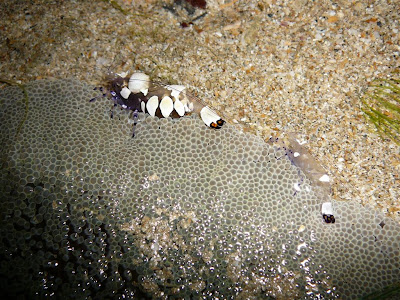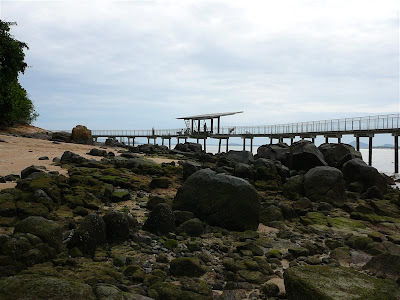Today we were at Sister's Island early in the morning, before the sun rises. Ron, Helen, July and I went over to the small lagoon to recce for common seastars while the others went straight to the bigger one first. The small lagoon has a lot of sandflies... Good thing July brought along insect repellent. Thanks!
From top left to bottom right: The land hermit crab is actually one of the threatened species in Singapore. Good that we can still see them at Sisters. The second photo I dont know what fish, but the 3rd one is the halfbeak where its upper jaw is much shorter than its lower jaw. The last photo is the snapping shrimp spotted by Helen.
Though carpet anemones are few, but I'm heartened to see this pair of anemone shrimp on one of the carpet anemones found.
This fish is really fun to play. When it sees you, it will bury itself into sand only with eyes sticking out as seen above at left side. When you disturb it a bit, it will come out like on the right side.
July pointed out this family of black sea cucumber... first time seeing many in one spot.
I think how these zoathids clump together can be pretty interesting.
It's the crabby part again! Here we found the red egg crab, grapsus crab, decorator crab and the swimming crab. First time seeing the decorator crab, it likes to decorate itself with sponges, seaweed etc to conceal from predators.
Ron found a blue spotted stingray.
Helen found this stealth toadfish in the lagoon...hehe.
How can a trip to Sisters be without flatworms. Though Sisters today is not as exciting as before which is cause of worry, glad to still be able to see this.
I was looking at the unknown sea cucumber as like the left photo. If you spot further, you might see what I saw. A pair of eyes belonging to a green fish. That was the best shot I could get.
The sun rises. Though not spectacular due to cloudy weather, it's still breath taking. The city lights are at the background.
Octopuses are quite common too and they are pretty interesting because they can change colours to blend into the surrounding.
WOW find of the day! Chay Hoon was so excited when she found it that she shouted "Basket seastar". I was wondering what on earth is that?? Simply because I dont know what it is. It is a seastar, can you see the five arms emerging from a central disk?
What is amazing is that from what I heard, basket seastars were last found in Singapore at 1896. Here is the one found then, dredged off St John Island. Now it is standing at Raffles Museum.
The other wow find especially for me must be this false clownfish or commonly known as nemo. It's my FIRST time seeing it and I've been longing to see it in the wild. To my orientation group who is named Finding nemo, I would like to say, found!
How can we forget the different variety of corals that reside at Sisters?
July had a great time with this bohol nudibranch (Discodoris boholensis). Because its called DISCOdoris, we were trying to view this nudibranch through the discos of water waves etc and other lame manners I have forgotten thankfully. Haaha.
Chay Hoon spotted another great find which is this smasher mantis shrimp. It has clubs to whack and stun predators. I will most likely miss finding it because it looks green like seaweed from top.
After a hearty breakfast, we waited at the jetty for the bumboat to fetch us back. And we were wondering what are these orange thingy? Nudibranch? Zoathids? Really curious.
This is the smaller sisters Island that I've not visited before, hopefully sometime soon. Byebye!
Saturday, June 30, 2007
A "basket" of surprise
Monday, June 25, 2007
Biodiversity of northern shores
Found in my project blog are a compilation of fauna found during recent trips to the northern shores. Of course, these are only what I've seen and it's definitely not exhaustive.
If interested, please visit http://cjproject.blogspot.com/2007/06/biodiversity-of-northern-shores.html :)
Thursday, June 21, 2007
A dynamic Chek Jawa
This time, two of my supervisors for my project, Siva and Dr Peter Todd, took precious time out to visit the field site with me during the last of the low spring tides. Appreciate it a lot. We were not there to just tour but its sort of a working trip, since its for a project. It's interesting and heartening to see them taking time out and then travel in a bumboat, rent bikes, negotiating the slopes of Ubin just to get to Chek Jawa.
After a brief walkthrough of the coral rubble area to see the survivals of the carpet anemones, we were back to the main sandbar. Sand dollars which usually are found in the northern part can now be found nearer South. If you look closely at the above photo, you can see some circular outlines. And there are a lot of sand dollars dwelling below the sand.
This is what you see when your hand reaches out to pick one and turn it around. A cake sand dollar (Arachnoides placenta)! They are the most commonly seen sand dollars on Chek Jawa. Their body is divided into 5 parts with tiny spines covering the entire body.
Here is our serious-looking Siva and Dr Peter deep in thoughts on the issues of the project.
Something that caught our attention was these black patches of slime covering a huge area of the lagoon nearer to the sand bar area.
A closer look. According to Siti of Teamseagrass, she commented that they are cyanobacteria and they usually come when there are more rain and go quickly too. Bad thing about them is they cover the seagrass.
After my two supervisors left since they have something on, I lingered on to collect some water samples for salinity tests. And we can see from this photo that the boardwalk is completed! Public can now access CJ via the boardwalk from 7th July.
Adding live to CJ will definitely be this pair of dogs.
and also this grey heron that walks around the intertidal flat to hunt for food. We saw one at the beginning of the day with a fish in its mouth. Wow. Looks like the early bird catches the "fish".

The beach is Pasir Ris park. Can you see the city outline at the back?
This trip was a great one, because it updates me how dynamic CJ is, with the movement of sandbar, change in seagrass communities, coming and going of cyanobacteria etc etc. Ecosystems are not static and changes has to take place. It's interesting to learn and study about these changes so that we can monitor and detect what changes are those that require our alert and attention.
Monday, June 18, 2007
Changi surprises me again
After a rainy weekend, here comes Monday which is also the bluey day for many. Grace, my brother and I were at Changi an hour before sunrise to catch the last -0.2m tide that exposes the intertidal flat. And many interesting finds await (which is impossible for me to put all the stuffs, thus picked the nicer and more interesting ones).
[Ria kindly suggested: The sea pencil didn't get stomped I think. There is a stiff inner portion and when the animal retracts into the ground, I think the top part of the body flops over. I see this with other kinds of sea pens as well as the sea pencil.]

This geographical seahare was huge but it had a shell like thing within its body on the left. Is that a parasite or what? Hope it's doing well.

Another of my first is this hairy seahare. They are really hairy and eject purple fluid upon disturbance.

These parakeets are residents of Changi village, adding melody and favour to the rustic place.Today was really a wonderful time.
Thank God again for surprising good weather despite negative forecasts and lightning seen last night. We have seen quite a lot of creatures. Some of which that are not mentioned above are the snails, ball sea cucumbers, sea fans, colonial tunicates, moult of horseshoe crab, crabs of several sorts, cuttlefish bone, mudskipper, zoathids, worms carpet anemones, onchs, hermit crabs etc.



















































